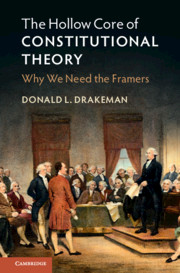Book contents
- The Hollow Core of Constitutional Theory
- The Hollow Core of Constitutional Theory
- Copyright page
- Contents
- Preface
- 1 The Framers and Contemporary Constitutional Theory
- 2 The Framers’ Intentions
- 3 Original Methods and the Limits of Interpretation
- 4 Original Methods Updating
- 5 The Semantic Summing Problem
- 6 Is Corpus Linguistics Better than Flipping a Coin?
- 7 The Framers’ Intentions Can Solve the Semantic Summing Problem
- 8 Interpretation and Sociological Legitimacy
- 9 Noninterpretive Decisions
- 10 Conclusion
- Bibliography
- Index
3 - Original Methods and the Limits of Interpretation
Published online by Cambridge University Press: 26 January 2021
- The Hollow Core of Constitutional Theory
- The Hollow Core of Constitutional Theory
- Copyright page
- Contents
- Preface
- 1 The Framers and Contemporary Constitutional Theory
- 2 The Framers’ Intentions
- 3 Original Methods and the Limits of Interpretation
- 4 Original Methods Updating
- 5 The Semantic Summing Problem
- 6 Is Corpus Linguistics Better than Flipping a Coin?
- 7 The Framers’ Intentions Can Solve the Semantic Summing Problem
- 8 Interpretation and Sociological Legitimacy
- 9 Noninterpretive Decisions
- 10 Conclusion
- Bibliography
- Index
Summary
This chapter demonstrates that the search for the lawmaker’s intentions – their end–means choice – was the central element of the Framers’ “original methods” of interpretation, as discussed by John McGinnis and Michael Rappaport. It also shows that dynamic or updated interpretations have an equally long heritage, although there is a sharp distinction between updated interpretations and judicial policymaking. The history of interpretation shows how it is possible to distinguish between decisions involving interpretive adaptations to new circumstances, and results-oriented, noninterpretive decisions.
- Type
- Chapter
- Information
- The Hollow Core of Constitutional TheoryWhy We Need the Framers, pp. 55 - 77Publisher: Cambridge University PressPrint publication year: 2021

